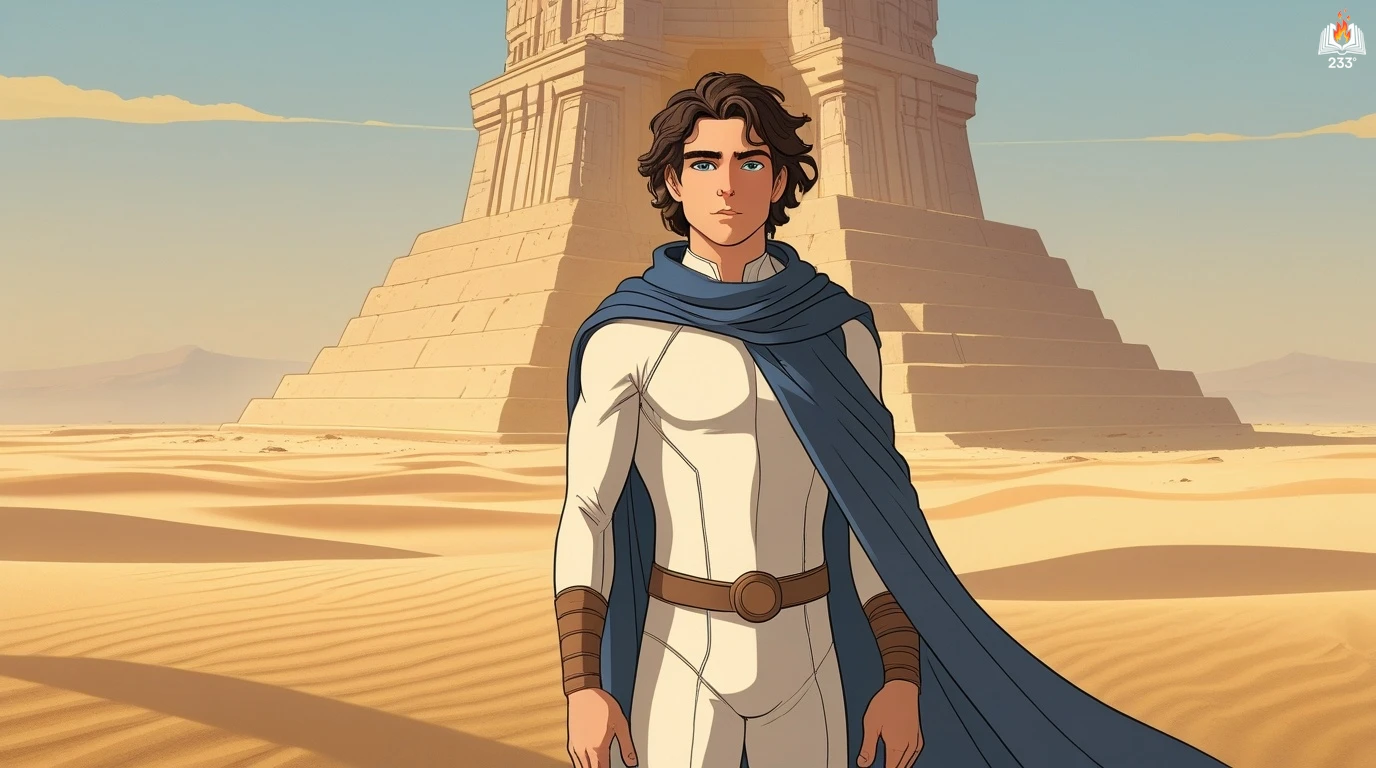God Emperor of Dune by Frank Herbert, published in 1981, is the fourth installment in the acclaimed Dune Chronicles series. Set over 3,500 years after the reign of Paul Atreides, it follows Leto II, Paul’s son, who has transformed into a human-sandworm hybrid and rules as a near-immortal tyrant over a stagnant empire. This novel serves as a pivotal bridge in the series, exploring themes of power, sacrifice, and human survival.
Plot Summary
For more than three thousand years, Leto Atreides II, once a boy of prophetic dreams, has ruled the empire as an almost-immortal being. No longer fully human, his body is fused with the sandtrout skin of Arrakis, reshaped into a grotesque hybrid of man and worm. On the arid planet once called Dune, now transformed into fertile land with only a desert remnant called the Sareer, Leto reigns with absolute control. His rule, known as Leto’s Peace, has stifled rebellion and ensured the survival of humanity through his Golden Path, a vision of sacrifice and control to steer humankind away from extinction.
Yet beneath the surface of enforced peace stirs a restless undercurrent. In the shadowed forests of the Sareer, Siona Atreides runs for her life. She is swift, sharp-minded, and resolute, heir to a rebellious spirit that defies Leto’s suffocating grip. Alongside companions, she dares a dangerous mission – to infiltrate the God Emperor’s Citadel and steal secrets that may unlock his vulnerability. But the D-wolves, monstrous guardians bred by Leto, pursue them relentlessly. One by one, her companions fall: Ulot, the plump thinker who lags behind; Kwuteg, the wiry strategist who buys her precious moments at the cost of his life. Only Siona plunges into the icy Idaho River, escaping the jaws of death.
Leto watches. Through his Ixian devices, he follows every step, yet he does not intervene. Siona fascinates him – her wild unpredictability, the spark that no prescient vision can trap. She carries the stolen volumes, copies of Leto’s own journals, and the detailed plans of the Citadel. The Emperor allows this breach, for it is part of the test, part of the shaping of the future. Siona’s survival matters more to him than the loss of any artifact. She is the seed of change.
Within the Citadel’s labyrinthine catacombs, the latest Duncan Idaho approaches. The countless generations of Duncans, cloned by the Tleilaxu, have served Leto faithfully – bodyguards, companions, reminders of the old Atreides loyalty. Yet each Duncan wrestles with his own awakening, his own rebellion. This Duncan senses his time nearing its edge. Rumors of replacement haunt him. The lasgun hidden in his briefcase is a testament to his doubts.
Leto waits in the dim heart of his domain, a cavernous chamber cradling the weight of memory. His body stretches seven meters, ribbed and massive, crowned by the once-human face. The scent of ancient dust and spice permeates the air as Duncan enters, tension taut as a drawn bow. They speak of Siona, of rebellion, of the subtle game of religion and control. Duncan reports the Bene Gesserit’s maneuvers, the cult of Alia rising on Giedi Prime, the intrigue rippling across the empire. Leto listens, voice thick with boredom and hidden amusement, knowing that beneath the words coils a deeper intent.
Duncan’s hand hovers near the briefcase. The lasgun or the report – the choice trembles in the air. At last, the weapon flashes forth, pointed at the Emperor’s exposed face. Betrayal, rebellion, desperation – Duncan’s defiance flares like a candle against a storm. Yet Leto, faster than thought, hurls his colossal body in a rolling arc, striking Duncan down, breaking bone and will alike. The ghola’s chest is crushed, breath rattling in his throat. As life slips away, Duncan murmurs Siona’s name – a thread of loyalty, a flicker of rebellion, extinguished.
Siona moves through her own trial. She is summoned to Leto’s presence, tested not with force, but with revelation. The Emperor leads her into the Sareer, through searing heat and desolation, stripping away her certainty. He grants her the spice trance, a transformation searing through her blood, awakening the ancestral memories locked within. Yet unlike Leto, who bears the unbearable burden of collective pasts, Siona emerges uniquely shielded from prescient vision. She becomes the fulcrum of change, the blind spot in the future that Leto needs to shatter stagnation.
Moneo, Siona’s father and Leto’s devoted majordomo, watches with trembling heart. Torn between obedience to the Emperor and love for his daughter, Moneo walks the knife-edge of survival. He serves, counsels, and fears, knowing that Leto’s grand design includes the downfall of his own family. Yet he remains, driven by faith, bound by duty.
As Leto’s empire strains under the weight of centuries, the tensions ripple outward. The Bene Gesserit maneuver in shadows, the Ixians craft devices to defy prescience, the Tleilaxu whisper in secret chambers. The God Emperor feels the cracks spreading. He has shaped humanity, pruned its extremes, crushed its ambitions – but he knows the trap of eternity. His own death, the ending of his reign, is the necessary shattering, the scattering that will seed the future.
In the final days, Leto walks into the trap he has crafted. Siona, armed with the knowledge and strength he has carefully fostered, takes her place at the heart of rebellion. Duncan, reborn once more, rises alongside her. The conspirators gather, and the great bridge across the river becomes the stage of destiny.
As the trap is sprung, Leto plunges from the bridge, his massive body crashing into the water, his form torn asunder by the forces of nature and his own design. The sandtrout that make up his body disperse into the currents, seeding the desert once more with the beginnings of sandworm life. Arrakis will become Dune again. The spice cycle will be reborn. And with Leto’s death, the empire will fracture, scattering humanity among the stars in an unpredictable diaspora, breaking the chains of prescient tyranny.
Siona and Duncan stand at the threshold of the new age, bearers of the burden Leto has placed upon them. The God Emperor is gone, but his shadow lingers, vast and inescapable. His Golden Path has been secured, at the price of his own life and the lives bound to him.
In the silence that follows, the sands stir once more, whispering of beginnings, of endings, and of the fragile, resilient thread of humanity stretching into the unknown.
Main Characters
Leto Atreides II: The God Emperor himself, Leto II has ruled the known universe for millennia, enforcing the “Golden Path,” a plan to secure humanity’s long-term survival. His transformation into a sandworm-human hybrid has given him near-immortality and vast prescient powers, but at the cost of his humanity. Leto is both tyrant and visionary, embodying sacrifice as he bears the burden of history and foresight.
Siona Atreides: A rebel leader and descendant of Leto, Siona is fierce, independent, and determined to resist Leto’s tyranny. Her arc revolves around testing her worthiness and eventually understanding her role in Leto’s grand plan. She embodies the unpredictability and resilience that Leto needs to ensure the future of humanity.
Duncan Idaho (ghola): A continually resurrected ghola (clone) of Paul Atreides’ loyal swordmaster, Duncan Idaho wrestles with loyalty, rebellion, and identity. Each version of Duncan struggles to reconcile his past selves with the present, ultimately becoming a symbol of human constancy and rebellion against Leto.
Moneo Atreides: Leto’s devoted majordomo and father of Siona, Moneo balances pragmatism and faith. Torn between loyalty to Leto and love for his rebellious daughter, he acts as a mediator, counselor, and sometimes voice of reason.
Theme
Power and Tyranny: Herbert interrogates the nature of absolute power through Leto, whose total control brings peace but stifles progress. The novel examines whether despotism can be justified if it secures humanity’s survival, presenting tyranny as both protector and prison.
Sacrifice and Transformation: Leto’s metamorphosis and rule demand profound personal sacrifice, including his own humanity. This theme extends to other characters, especially Siona, who must undergo trials that challenge and transform her, reflecting on the cost of change.
Survival and the Golden Path: Leto’s Golden Path symbolizes long-term survival over short-term comfort. The theme probes the tension between preserving life and preserving freedom, questioning what survival truly means when stripped of vitality and spontaneity.
Memory, History, and Identity: With ancestral memories and cloned Duncans, the novel explores the burdens of memory and the search for authentic identity. Leto’s internal struggle and Duncan’s repeated rebirths embody the tension between past and present.
Religion and Myth: Herbert weaves a critique of religious authority and myth-making, showing how Leto becomes both a god and a cautionary figure. The rise of cults, rituals, and the worship of Leto and his family reveal how societies use myth to explain, control, or rebel.
Writing Style and Tone
Frank Herbert’s writing in God Emperor of Dune marks a significant shift from the earlier novels in the series. While the first three Dune books are known for their intricate plots and political machinations, this volume adopts a more philosophical, introspective tone. Much of the narrative unfolds through long dialogues, monologues, and journal entries (notably Leto’s “Stolen Journals”), where characters grapple with existential questions, moral dilemmas, and sweeping historical reflections. The pace slows deliberately, focusing less on external action and more on internal and ideological struggle.
Herbert’s language is dense, poetic, and often aphoristic, packed with paradoxes, layered meanings, and mythic resonance. He uses Leto’s inhuman perspective to create a voice that oscillates between intimate confession and detached observation, evoking both awe and unease. This cerebral tone is balanced by moments of tension and raw emotion, particularly in Siona’s rebellion and Duncan’s crises of loyalty, providing human counterpoints to the God Emperor’s vast perspective.
We hope this summary has sparked your interest and would appreciate you following Celsius 233 on social media:
There’s a treasure trove of other fascinating book summaries waiting for you. Check out our collection of stories that inspire, thrill, and provoke thought, just like this one by checking out the Book Shelf or the Library
Remember, while our summaries capture the essence, they can never replace the full experience of reading the book. If this summary intrigued you, consider diving into the complete story – buy the book and immerse yourself in the author’s original work.
If you want to request a book summary, click here.
When Saurabh is not working/watching football/reading books/traveling, you can reach him via Twitter/X, LinkedIn, or Threads
Restart reading!








